Total Quality Management: Principles, Implementation, and Importance
VerifiedAdded on 2023/06/16
|15
|3277
|402
Essay
AI Summary
This essay provides a detailed overview of Total Quality Management (TQM), a popular operational management theory focused on quality control, holistic approaches, and customer-centric strategies. The assignment begins with a background and definition of TQM, followed by an in-depth discussion of its principles, associated factors, implementation strategies, importance, and limitations. Key principles include customer importance, employee development, process focus, integrated processes, strategic management, fact-based decision making, continuous improvement, and effective communication. The essay also explores the tools and techniques used for TQM implementation, such as benchmarking, training, ISO standards, statistical process control, and the PDSA cycle. It highlights the benefits of TQM, including a strong market presence, improved productivity, adaptability, waste reduction, and fair pricing. The conclusion emphasizes the value of TQM in enhancing customer relationships and stakeholder value.
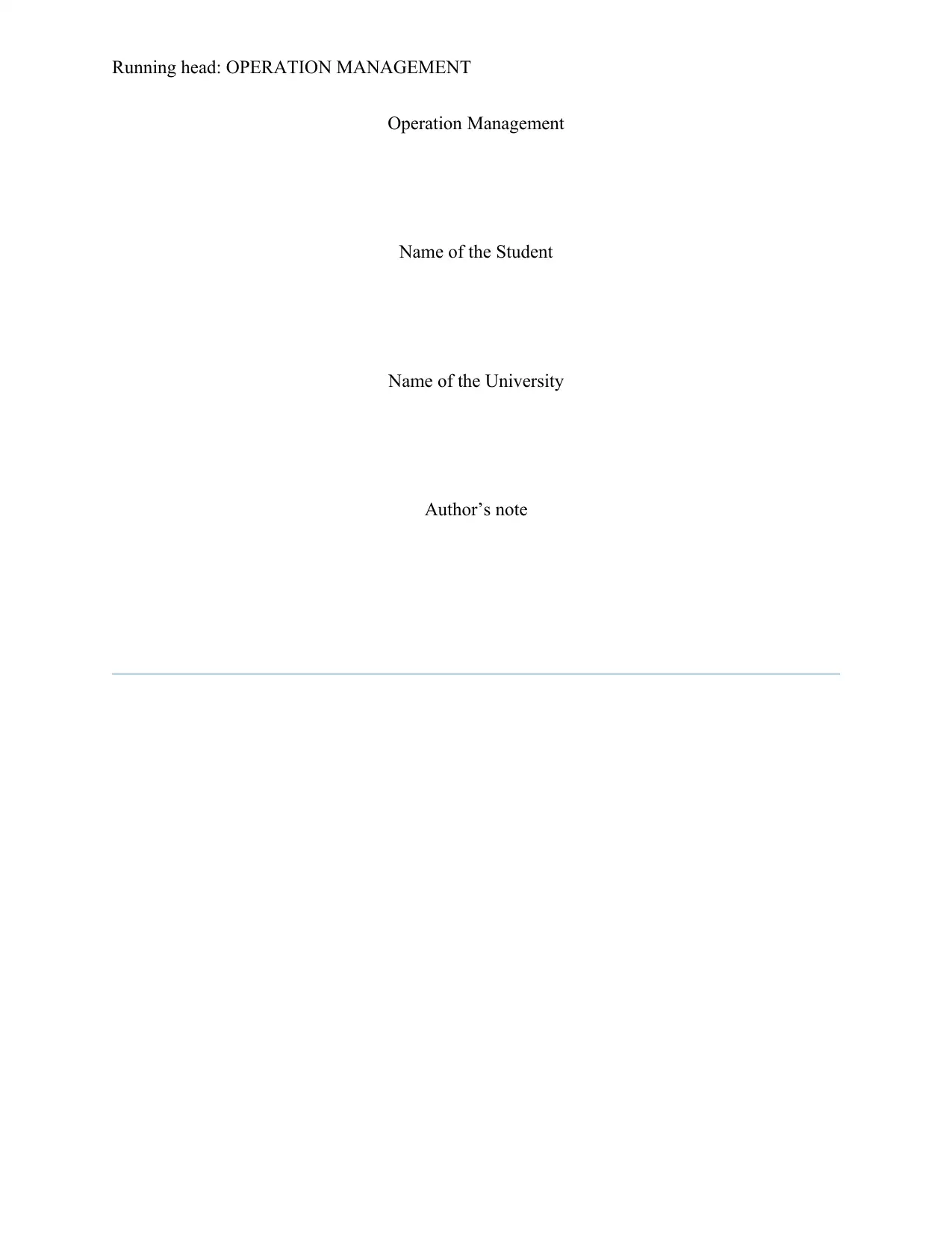
Running head: OPERATION MANAGEMENT
Operation Management
Name of the Student
Name of the University
Author’s note
Operation Management
Name of the Student
Name of the University
Author’s note
Paraphrase This Document
Need a fresh take? Get an instant paraphrase of this document with our AI Paraphraser
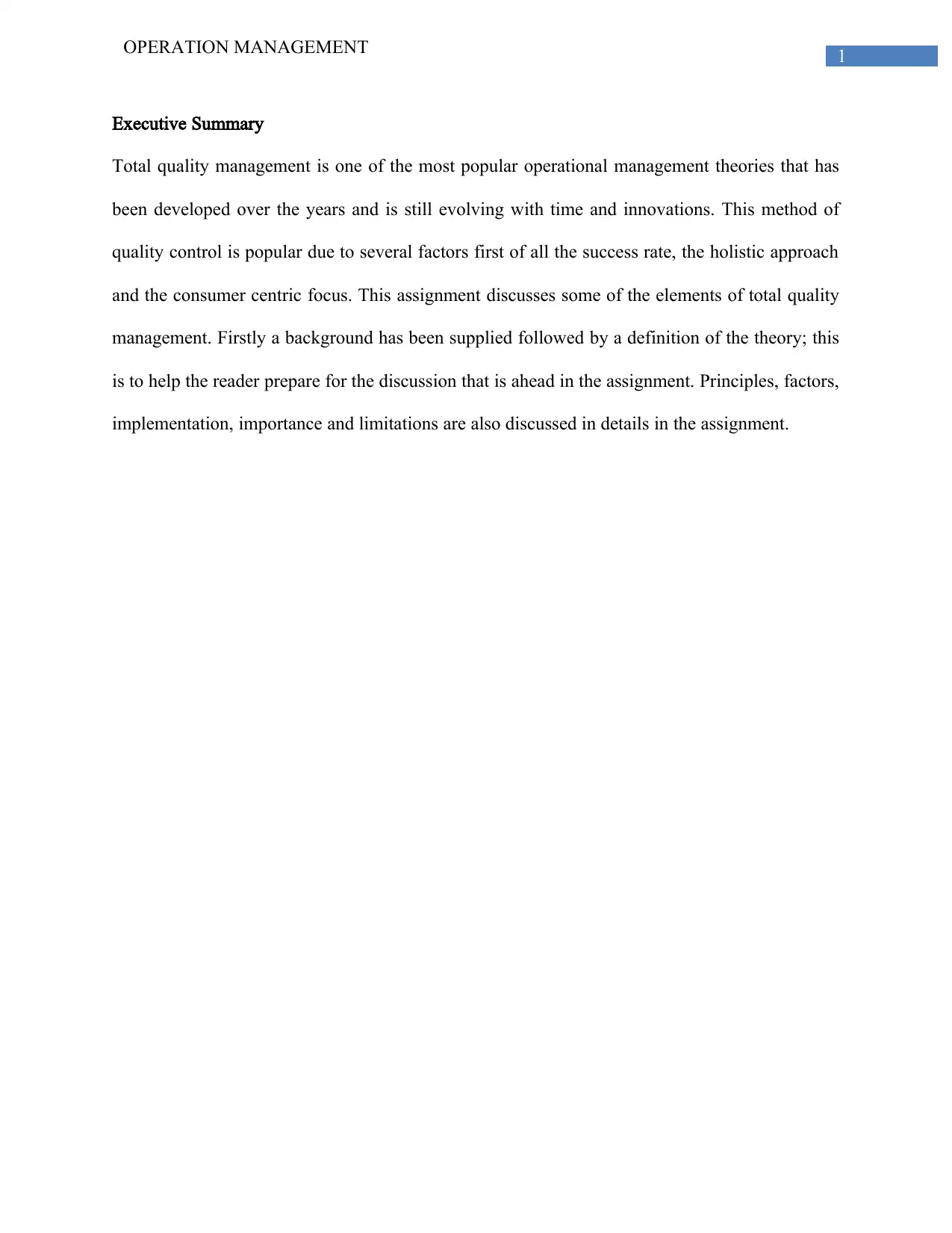
1OPERATION MANAGEMENT
Executive Summary
Total quality management is one of the most popular operational management theories that has
been developed over the years and is still evolving with time and innovations. This method of
quality control is popular due to several factors first of all the success rate, the holistic approach
and the consumer centric focus. This assignment discusses some of the elements of total quality
management. Firstly a background has been supplied followed by a definition of the theory; this
is to help the reader prepare for the discussion that is ahead in the assignment. Principles, factors,
implementation, importance and limitations are also discussed in details in the assignment.
Executive Summary
Total quality management is one of the most popular operational management theories that has
been developed over the years and is still evolving with time and innovations. This method of
quality control is popular due to several factors first of all the success rate, the holistic approach
and the consumer centric focus. This assignment discusses some of the elements of total quality
management. Firstly a background has been supplied followed by a definition of the theory; this
is to help the reader prepare for the discussion that is ahead in the assignment. Principles, factors,
implementation, importance and limitations are also discussed in details in the assignment.
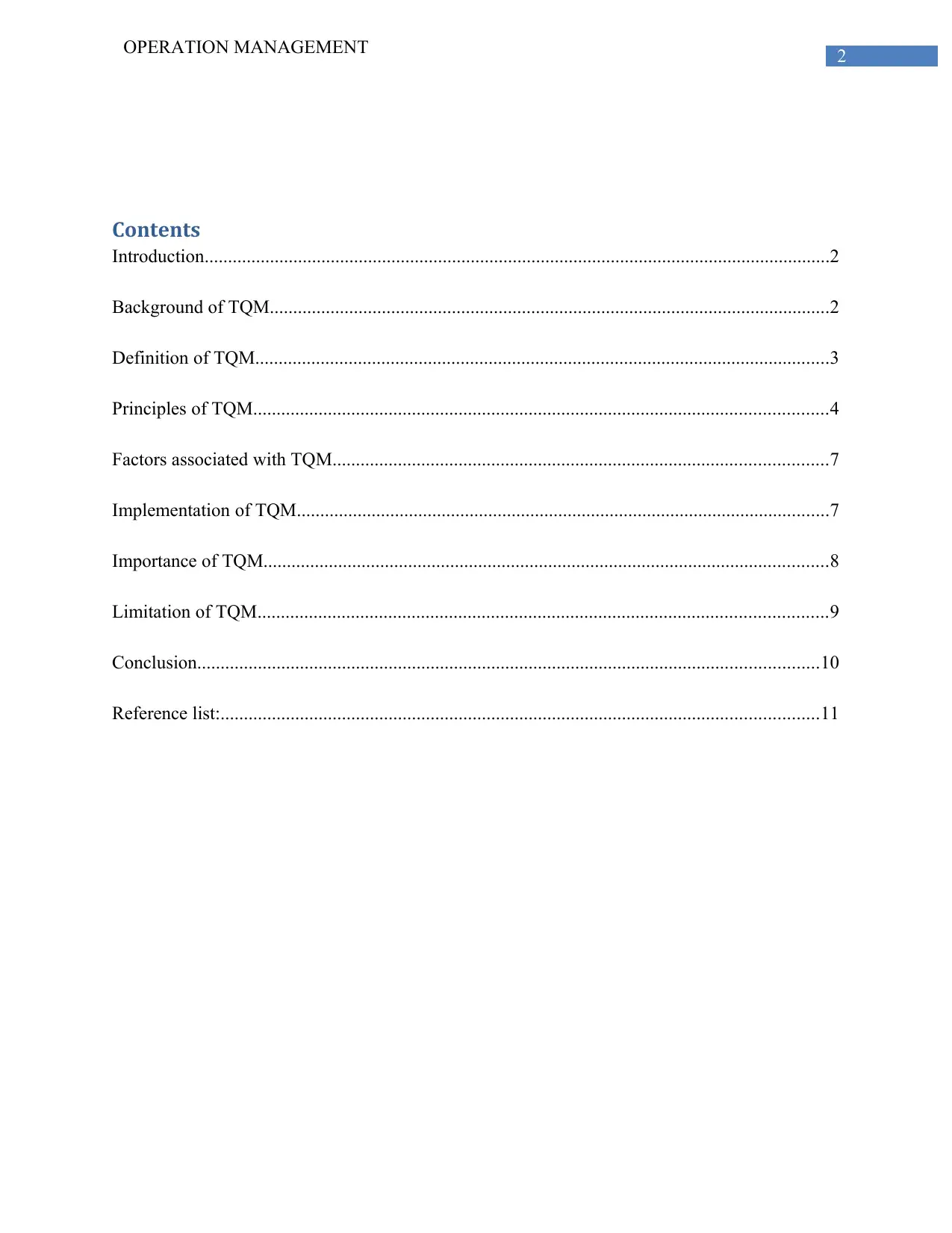
2OPERATION MANAGEMENT
Contents
Introduction......................................................................................................................................2
Background of TQM........................................................................................................................2
Definition of TQM...........................................................................................................................3
Principles of TQM...........................................................................................................................4
Factors associated with TQM..........................................................................................................7
Implementation of TQM..................................................................................................................7
Importance of TQM.........................................................................................................................8
Limitation of TQM..........................................................................................................................9
Conclusion.....................................................................................................................................10
Reference list:................................................................................................................................11
Contents
Introduction......................................................................................................................................2
Background of TQM........................................................................................................................2
Definition of TQM...........................................................................................................................3
Principles of TQM...........................................................................................................................4
Factors associated with TQM..........................................................................................................7
Implementation of TQM..................................................................................................................7
Importance of TQM.........................................................................................................................8
Limitation of TQM..........................................................................................................................9
Conclusion.....................................................................................................................................10
Reference list:................................................................................................................................11
⊘ This is a preview!⊘
Do you want full access?
Subscribe today to unlock all pages.

Trusted by 1+ million students worldwide
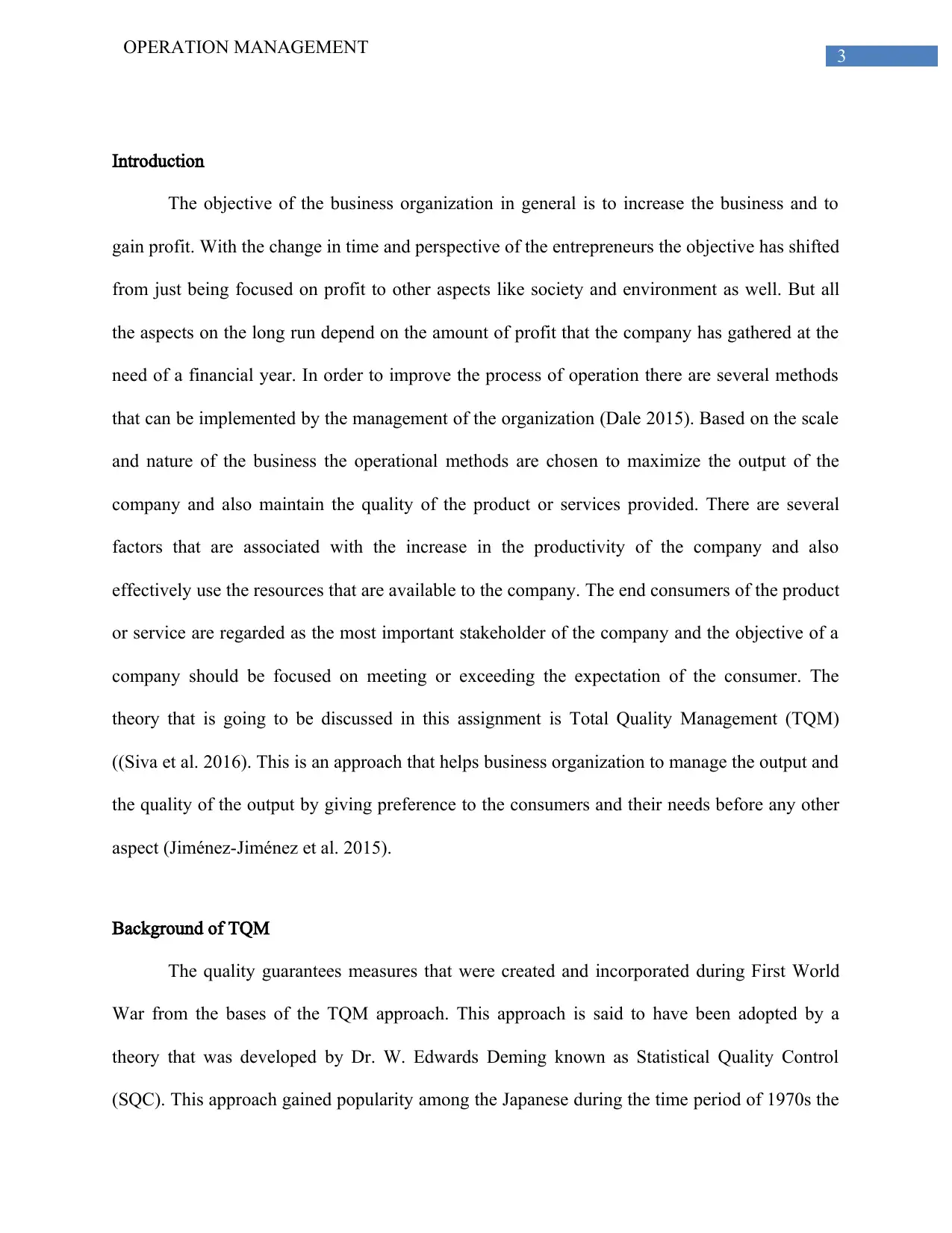
3OPERATION MANAGEMENT
Introduction
The objective of the business organization in general is to increase the business and to
gain profit. With the change in time and perspective of the entrepreneurs the objective has shifted
from just being focused on profit to other aspects like society and environment as well. But all
the aspects on the long run depend on the amount of profit that the company has gathered at the
need of a financial year. In order to improve the process of operation there are several methods
that can be implemented by the management of the organization (Dale 2015). Based on the scale
and nature of the business the operational methods are chosen to maximize the output of the
company and also maintain the quality of the product or services provided. There are several
factors that are associated with the increase in the productivity of the company and also
effectively use the resources that are available to the company. The end consumers of the product
or service are regarded as the most important stakeholder of the company and the objective of a
company should be focused on meeting or exceeding the expectation of the consumer. The
theory that is going to be discussed in this assignment is Total Quality Management (TQM)
((Siva et al. 2016). This is an approach that helps business organization to manage the output and
the quality of the output by giving preference to the consumers and their needs before any other
aspect (Jiménez-Jiménez et al. 2015).
Background of TQM
The quality guarantees measures that were created and incorporated during First World
War from the bases of the TQM approach. This approach is said to have been adopted by a
theory that was developed by Dr. W. Edwards Deming known as Statistical Quality Control
(SQC). This approach gained popularity among the Japanese during the time period of 1970s the
Introduction
The objective of the business organization in general is to increase the business and to
gain profit. With the change in time and perspective of the entrepreneurs the objective has shifted
from just being focused on profit to other aspects like society and environment as well. But all
the aspects on the long run depend on the amount of profit that the company has gathered at the
need of a financial year. In order to improve the process of operation there are several methods
that can be implemented by the management of the organization (Dale 2015). Based on the scale
and nature of the business the operational methods are chosen to maximize the output of the
company and also maintain the quality of the product or services provided. There are several
factors that are associated with the increase in the productivity of the company and also
effectively use the resources that are available to the company. The end consumers of the product
or service are regarded as the most important stakeholder of the company and the objective of a
company should be focused on meeting or exceeding the expectation of the consumer. The
theory that is going to be discussed in this assignment is Total Quality Management (TQM)
((Siva et al. 2016). This is an approach that helps business organization to manage the output and
the quality of the output by giving preference to the consumers and their needs before any other
aspect (Jiménez-Jiménez et al. 2015).
Background of TQM
The quality guarantees measures that were created and incorporated during First World
War from the bases of the TQM approach. This approach is said to have been adopted by a
theory that was developed by Dr. W. Edwards Deming known as Statistical Quality Control
(SQC). This approach gained popularity among the Japanese during the time period of 1970s the
Paraphrase This Document
Need a fresh take? Get an instant paraphrase of this document with our AI Paraphraser
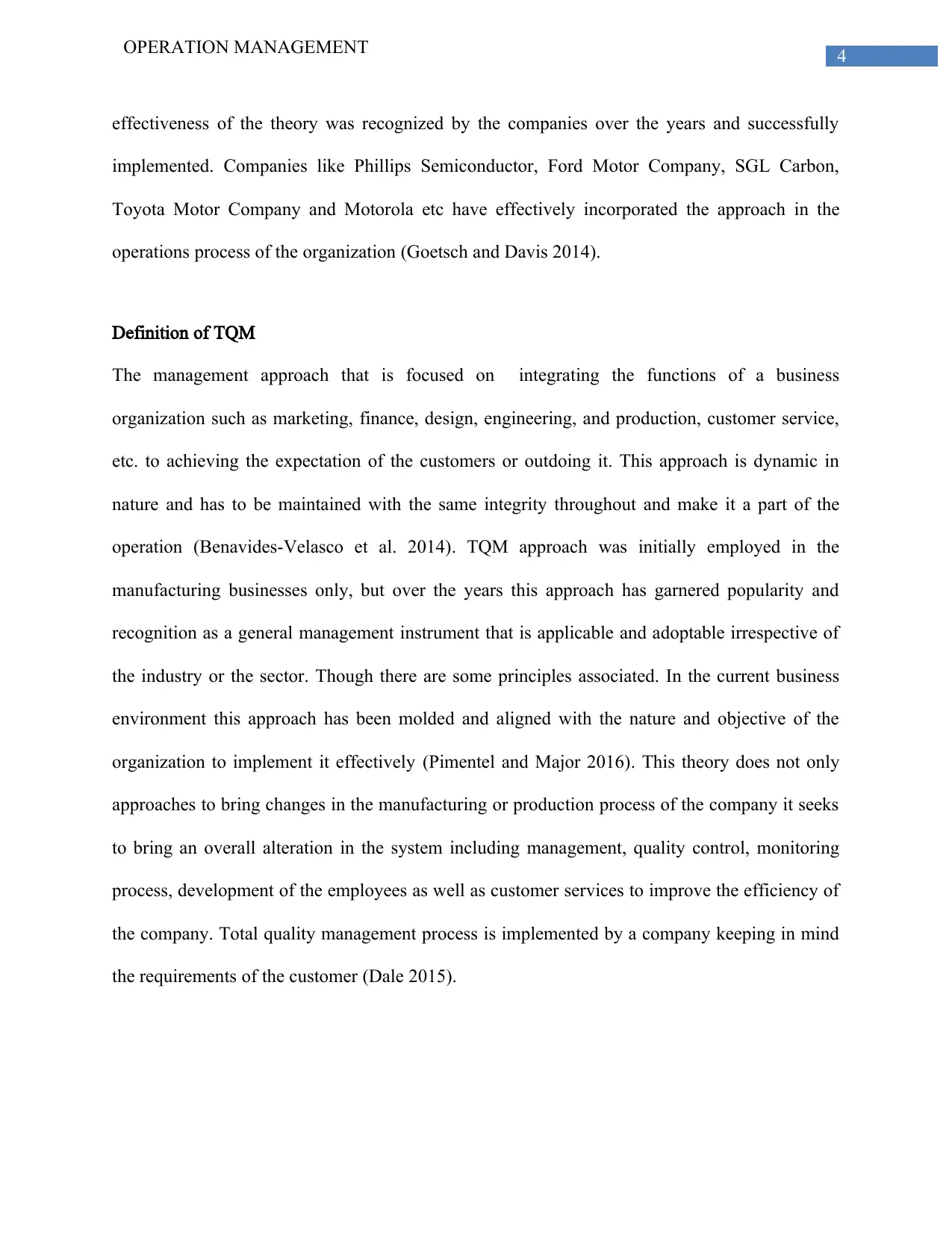
4OPERATION MANAGEMENT
effectiveness of the theory was recognized by the companies over the years and successfully
implemented. Companies like Phillips Semiconductor, Ford Motor Company, SGL Carbon,
Toyota Motor Company and Motorola etc have effectively incorporated the approach in the
operations process of the organization (Goetsch and Davis 2014).
Definition of TQM
The management approach that is focused on integrating the functions of a business
organization such as marketing, finance, design, engineering, and production, customer service,
etc. to achieving the expectation of the customers or outdoing it. This approach is dynamic in
nature and has to be maintained with the same integrity throughout and make it a part of the
operation (Benavides-Velasco et al. 2014). TQM approach was initially employed in the
manufacturing businesses only, but over the years this approach has garnered popularity and
recognition as a general management instrument that is applicable and adoptable irrespective of
the industry or the sector. Though there are some principles associated. In the current business
environment this approach has been molded and aligned with the nature and objective of the
organization to implement it effectively (Pimentel and Major 2016). This theory does not only
approaches to bring changes in the manufacturing or production process of the company it seeks
to bring an overall alteration in the system including management, quality control, monitoring
process, development of the employees as well as customer services to improve the efficiency of
the company. Total quality management process is implemented by a company keeping in mind
the requirements of the customer (Dale 2015).
effectiveness of the theory was recognized by the companies over the years and successfully
implemented. Companies like Phillips Semiconductor, Ford Motor Company, SGL Carbon,
Toyota Motor Company and Motorola etc have effectively incorporated the approach in the
operations process of the organization (Goetsch and Davis 2014).
Definition of TQM
The management approach that is focused on integrating the functions of a business
organization such as marketing, finance, design, engineering, and production, customer service,
etc. to achieving the expectation of the customers or outdoing it. This approach is dynamic in
nature and has to be maintained with the same integrity throughout and make it a part of the
operation (Benavides-Velasco et al. 2014). TQM approach was initially employed in the
manufacturing businesses only, but over the years this approach has garnered popularity and
recognition as a general management instrument that is applicable and adoptable irrespective of
the industry or the sector. Though there are some principles associated. In the current business
environment this approach has been molded and aligned with the nature and objective of the
organization to implement it effectively (Pimentel and Major 2016). This theory does not only
approaches to bring changes in the manufacturing or production process of the company it seeks
to bring an overall alteration in the system including management, quality control, monitoring
process, development of the employees as well as customer services to improve the efficiency of
the company. Total quality management process is implemented by a company keeping in mind
the requirements of the customer (Dale 2015).
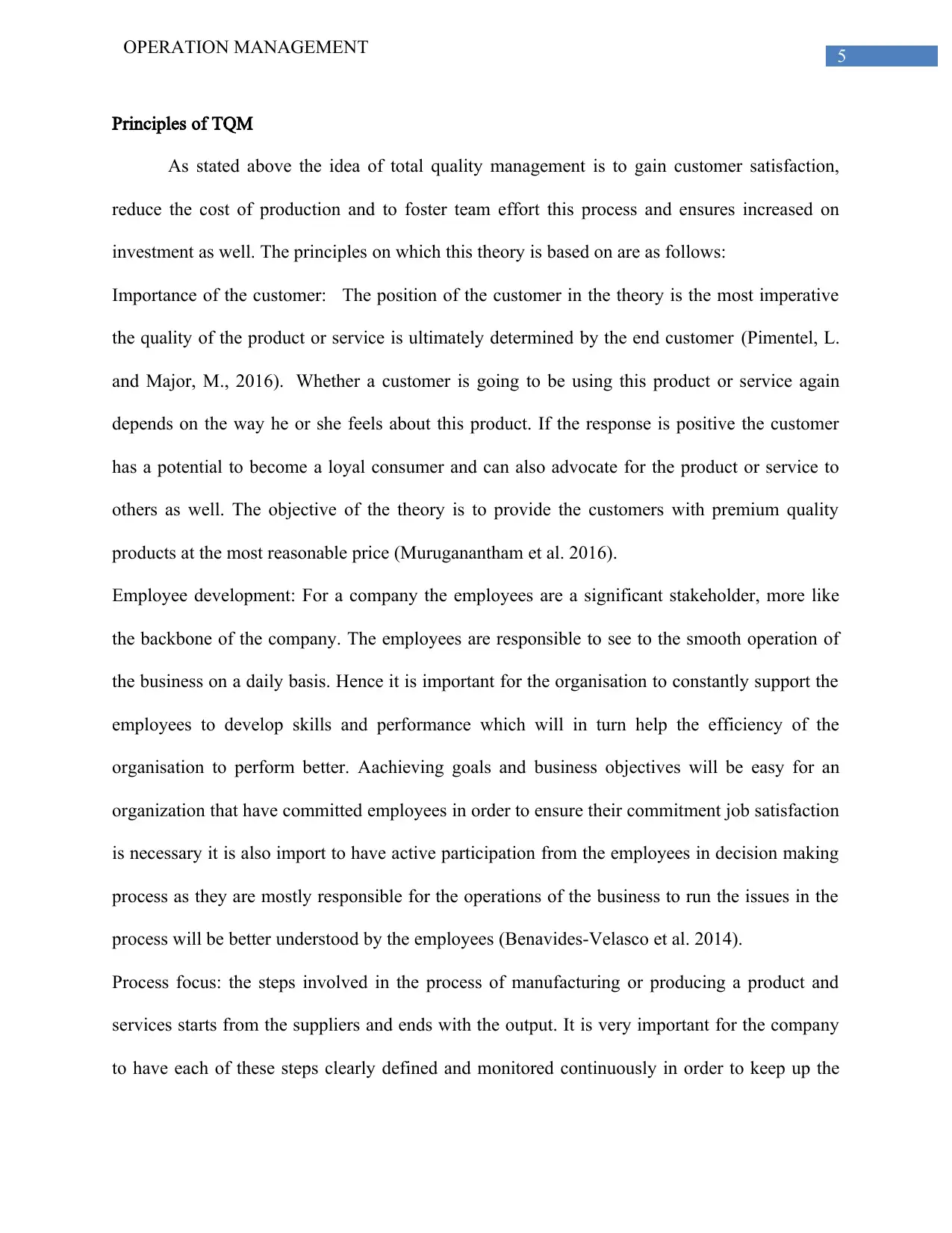
5OPERATION MANAGEMENT
Principles of TQM
As stated above the idea of total quality management is to gain customer satisfaction,
reduce the cost of production and to foster team effort this process and ensures increased on
investment as well. The principles on which this theory is based on are as follows:
Importance of the customer: The position of the customer in the theory is the most imperative
the quality of the product or service is ultimately determined by the end customer (Pimentel, L.
and Major, M., 2016). Whether a customer is going to be using this product or service again
depends on the way he or she feels about this product. If the response is positive the customer
has a potential to become a loyal consumer and can also advocate for the product or service to
others as well. The objective of the theory is to provide the customers with premium quality
products at the most reasonable price (Muruganantham et al. 2016).
Employee development: For a company the employees are a significant stakeholder, more like
the backbone of the company. The employees are responsible to see to the smooth operation of
the business on a daily basis. Hence it is important for the organisation to constantly support the
employees to develop skills and performance which will in turn help the efficiency of the
organisation to perform better. Aachieving goals and business objectives will be easy for an
organization that have committed employees in order to ensure their commitment job satisfaction
is necessary it is also import to have active participation from the employees in decision making
process as they are mostly responsible for the operations of the business to run the issues in the
process will be better understood by the employees (Benavides-Velasco et al. 2014).
Process focus: the steps involved in the process of manufacturing or producing a product and
services starts from the suppliers and ends with the output. It is very important for the company
to have each of these steps clearly defined and monitored continuously in order to keep up the
Principles of TQM
As stated above the idea of total quality management is to gain customer satisfaction,
reduce the cost of production and to foster team effort this process and ensures increased on
investment as well. The principles on which this theory is based on are as follows:
Importance of the customer: The position of the customer in the theory is the most imperative
the quality of the product or service is ultimately determined by the end customer (Pimentel, L.
and Major, M., 2016). Whether a customer is going to be using this product or service again
depends on the way he or she feels about this product. If the response is positive the customer
has a potential to become a loyal consumer and can also advocate for the product or service to
others as well. The objective of the theory is to provide the customers with premium quality
products at the most reasonable price (Muruganantham et al. 2016).
Employee development: For a company the employees are a significant stakeholder, more like
the backbone of the company. The employees are responsible to see to the smooth operation of
the business on a daily basis. Hence it is important for the organisation to constantly support the
employees to develop skills and performance which will in turn help the efficiency of the
organisation to perform better. Aachieving goals and business objectives will be easy for an
organization that have committed employees in order to ensure their commitment job satisfaction
is necessary it is also import to have active participation from the employees in decision making
process as they are mostly responsible for the operations of the business to run the issues in the
process will be better understood by the employees (Benavides-Velasco et al. 2014).
Process focus: the steps involved in the process of manufacturing or producing a product and
services starts from the suppliers and ends with the output. It is very important for the company
to have each of these steps clearly defined and monitored continuously in order to keep up the
⊘ This is a preview!⊘
Do you want full access?
Subscribe today to unlock all pages.

Trusted by 1+ million students worldwide
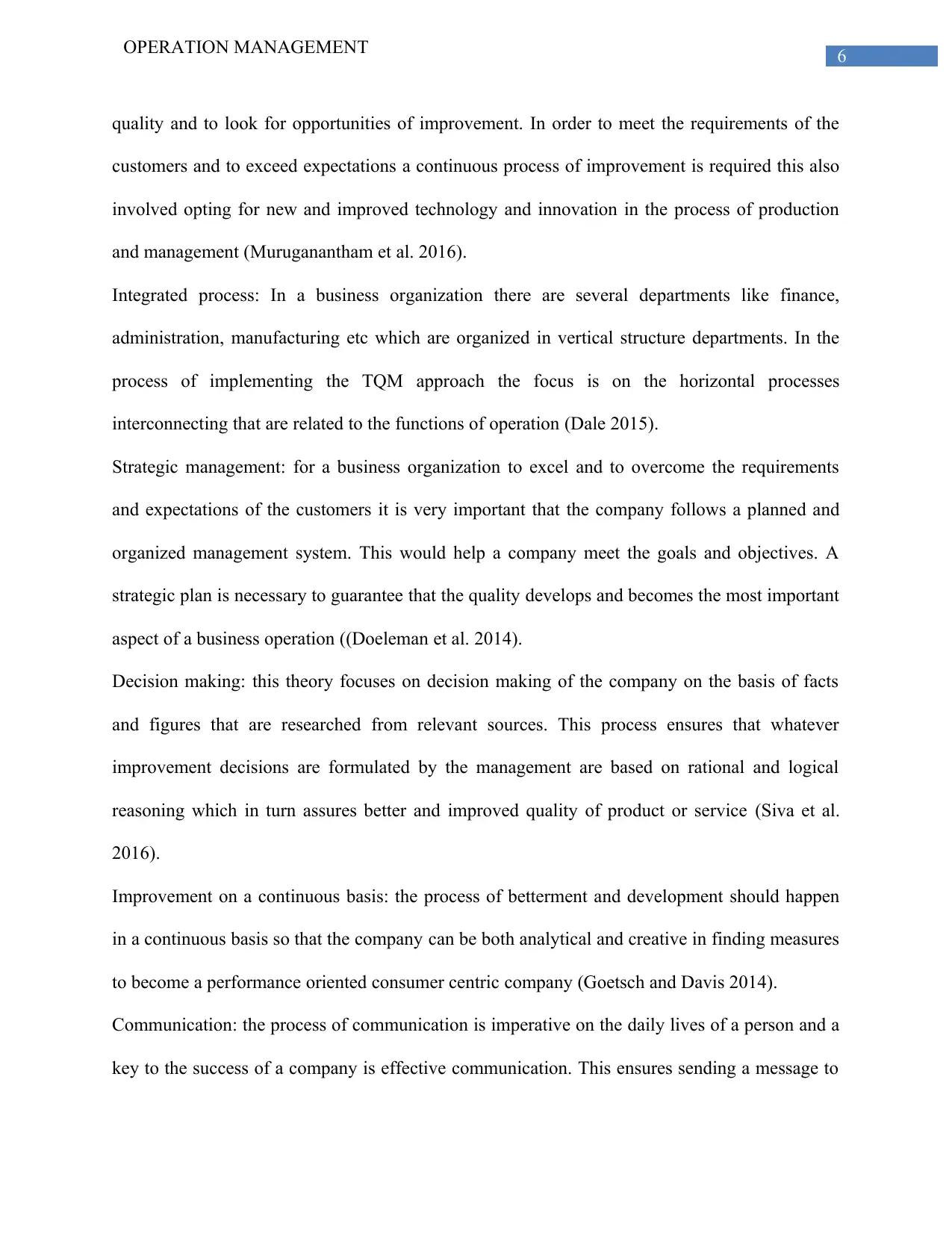
6OPERATION MANAGEMENT
quality and to look for opportunities of improvement. In order to meet the requirements of the
customers and to exceed expectations a continuous process of improvement is required this also
involved opting for new and improved technology and innovation in the process of production
and management (Muruganantham et al. 2016).
Integrated process: In a business organization there are several departments like finance,
administration, manufacturing etc which are organized in vertical structure departments. In the
process of implementing the TQM approach the focus is on the horizontal processes
interconnecting that are related to the functions of operation (Dale 2015).
Strategic management: for a business organization to excel and to overcome the requirements
and expectations of the customers it is very important that the company follows a planned and
organized management system. This would help a company meet the goals and objectives. A
strategic plan is necessary to guarantee that the quality develops and becomes the most important
aspect of a business operation ((Doeleman et al. 2014).
Decision making: this theory focuses on decision making of the company on the basis of facts
and figures that are researched from relevant sources. This process ensures that whatever
improvement decisions are formulated by the management are based on rational and logical
reasoning which in turn assures better and improved quality of product or service (Siva et al.
2016).
Improvement on a continuous basis: the process of betterment and development should happen
in a continuous basis so that the company can be both analytical and creative in finding measures
to become a performance oriented consumer centric company (Goetsch and Davis 2014).
Communication: the process of communication is imperative on the daily lives of a person and a
key to the success of a company is effective communication. This ensures sending a message to
quality and to look for opportunities of improvement. In order to meet the requirements of the
customers and to exceed expectations a continuous process of improvement is required this also
involved opting for new and improved technology and innovation in the process of production
and management (Muruganantham et al. 2016).
Integrated process: In a business organization there are several departments like finance,
administration, manufacturing etc which are organized in vertical structure departments. In the
process of implementing the TQM approach the focus is on the horizontal processes
interconnecting that are related to the functions of operation (Dale 2015).
Strategic management: for a business organization to excel and to overcome the requirements
and expectations of the customers it is very important that the company follows a planned and
organized management system. This would help a company meet the goals and objectives. A
strategic plan is necessary to guarantee that the quality develops and becomes the most important
aspect of a business operation ((Doeleman et al. 2014).
Decision making: this theory focuses on decision making of the company on the basis of facts
and figures that are researched from relevant sources. This process ensures that whatever
improvement decisions are formulated by the management are based on rational and logical
reasoning which in turn assures better and improved quality of product or service (Siva et al.
2016).
Improvement on a continuous basis: the process of betterment and development should happen
in a continuous basis so that the company can be both analytical and creative in finding measures
to become a performance oriented consumer centric company (Goetsch and Davis 2014).
Communication: the process of communication is imperative on the daily lives of a person and a
key to the success of a company is effective communication. This ensures sending a message to
Paraphrase This Document
Need a fresh take? Get an instant paraphrase of this document with our AI Paraphraser
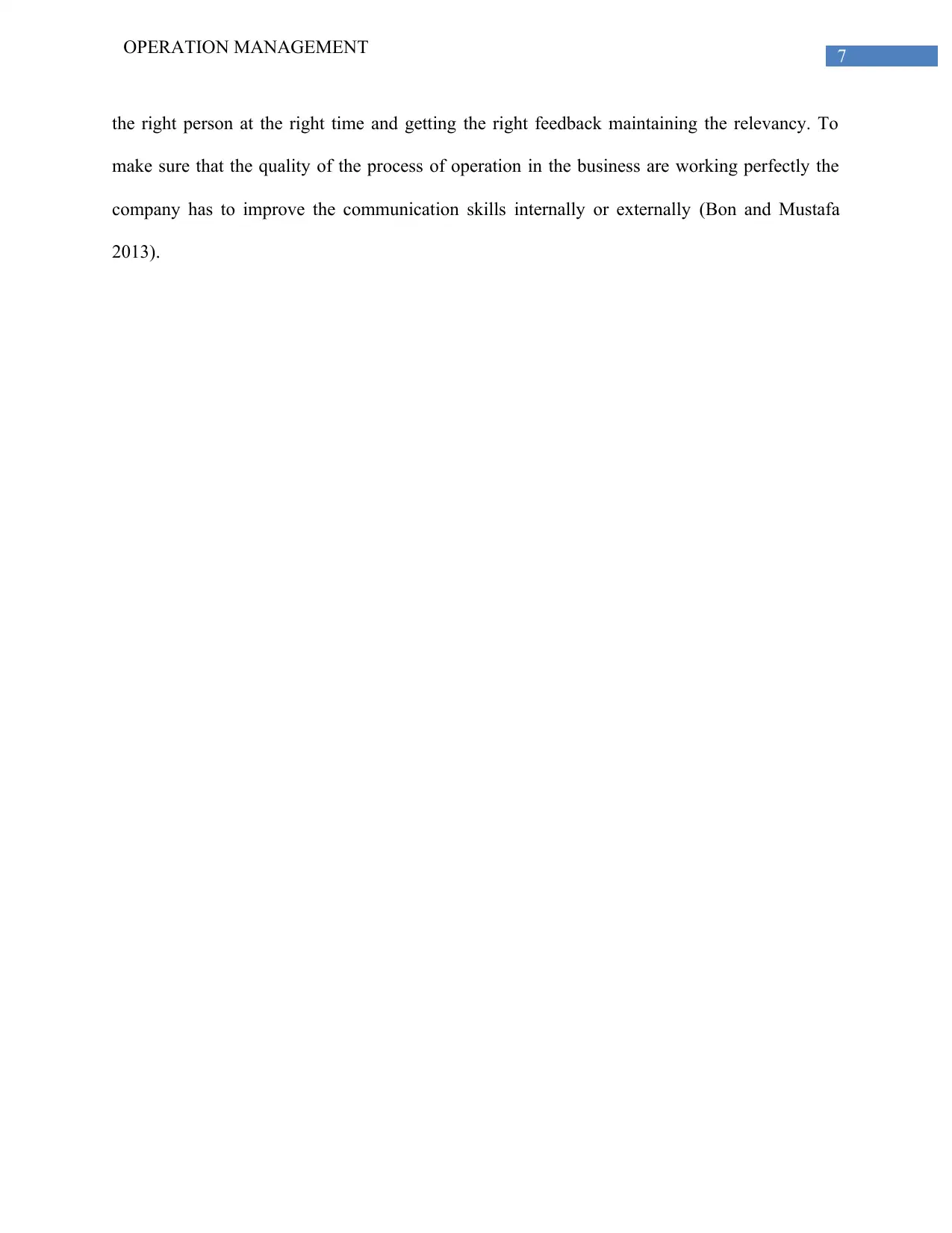
7OPERATION MANAGEMENT
the right person at the right time and getting the right feedback maintaining the relevancy. To
make sure that the quality of the process of operation in the business are working perfectly the
company has to improve the communication skills internally or externally (Bon and Mustafa
2013).
the right person at the right time and getting the right feedback maintaining the relevancy. To
make sure that the quality of the process of operation in the business are working perfectly the
company has to improve the communication skills internally or externally (Bon and Mustafa
2013).
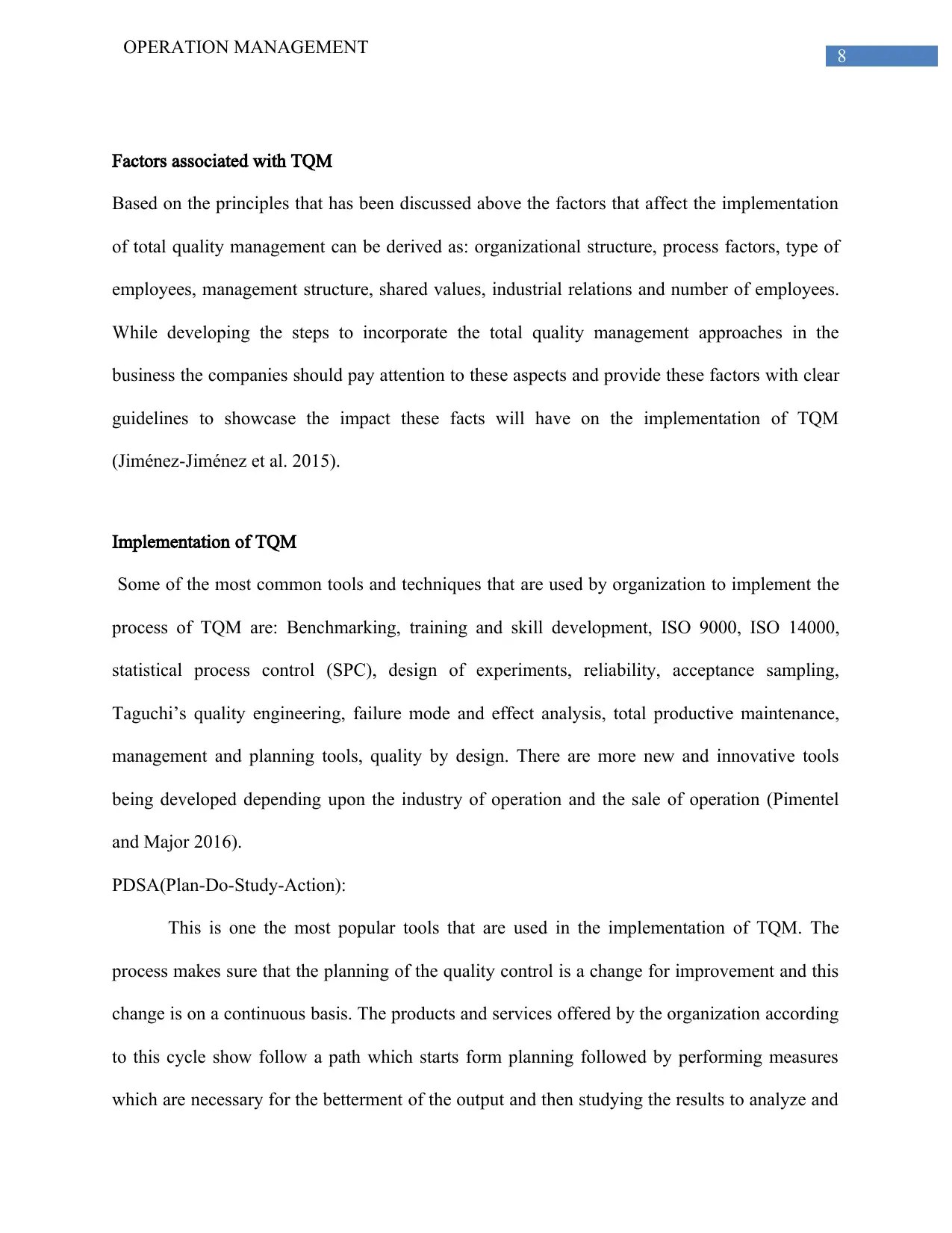
8OPERATION MANAGEMENT
Factors associated with TQM
Based on the principles that has been discussed above the factors that affect the implementation
of total quality management can be derived as: organizational structure, process factors, type of
employees, management structure, shared values, industrial relations and number of employees.
While developing the steps to incorporate the total quality management approaches in the
business the companies should pay attention to these aspects and provide these factors with clear
guidelines to showcase the impact these facts will have on the implementation of TQM
(Jiménez-Jiménez et al. 2015).
Implementation of TQM
Some of the most common tools and techniques that are used by organization to implement the
process of TQM are: Benchmarking, training and skill development, ISO 9000, ISO 14000,
statistical process control (SPC), design of experiments, reliability, acceptance sampling,
Taguchi’s quality engineering, failure mode and effect analysis, total productive maintenance,
management and planning tools, quality by design. There are more new and innovative tools
being developed depending upon the industry of operation and the sale of operation (Pimentel
and Major 2016).
PDSA(Plan-Do-Study-Action):
This is one the most popular tools that are used in the implementation of TQM. The
process makes sure that the planning of the quality control is a change for improvement and this
change is on a continuous basis. The products and services offered by the organization according
to this cycle show follow a path which starts form planning followed by performing measures
which are necessary for the betterment of the output and then studying the results to analyze and
Factors associated with TQM
Based on the principles that has been discussed above the factors that affect the implementation
of total quality management can be derived as: organizational structure, process factors, type of
employees, management structure, shared values, industrial relations and number of employees.
While developing the steps to incorporate the total quality management approaches in the
business the companies should pay attention to these aspects and provide these factors with clear
guidelines to showcase the impact these facts will have on the implementation of TQM
(Jiménez-Jiménez et al. 2015).
Implementation of TQM
Some of the most common tools and techniques that are used by organization to implement the
process of TQM are: Benchmarking, training and skill development, ISO 9000, ISO 14000,
statistical process control (SPC), design of experiments, reliability, acceptance sampling,
Taguchi’s quality engineering, failure mode and effect analysis, total productive maintenance,
management and planning tools, quality by design. There are more new and innovative tools
being developed depending upon the industry of operation and the sale of operation (Pimentel
and Major 2016).
PDSA(Plan-Do-Study-Action):
This is one the most popular tools that are used in the implementation of TQM. The
process makes sure that the planning of the quality control is a change for improvement and this
change is on a continuous basis. The products and services offered by the organization according
to this cycle show follow a path which starts form planning followed by performing measures
which are necessary for the betterment of the output and then studying the results to analyze and
⊘ This is a preview!⊘
Do you want full access?
Subscribe today to unlock all pages.

Trusted by 1+ million students worldwide
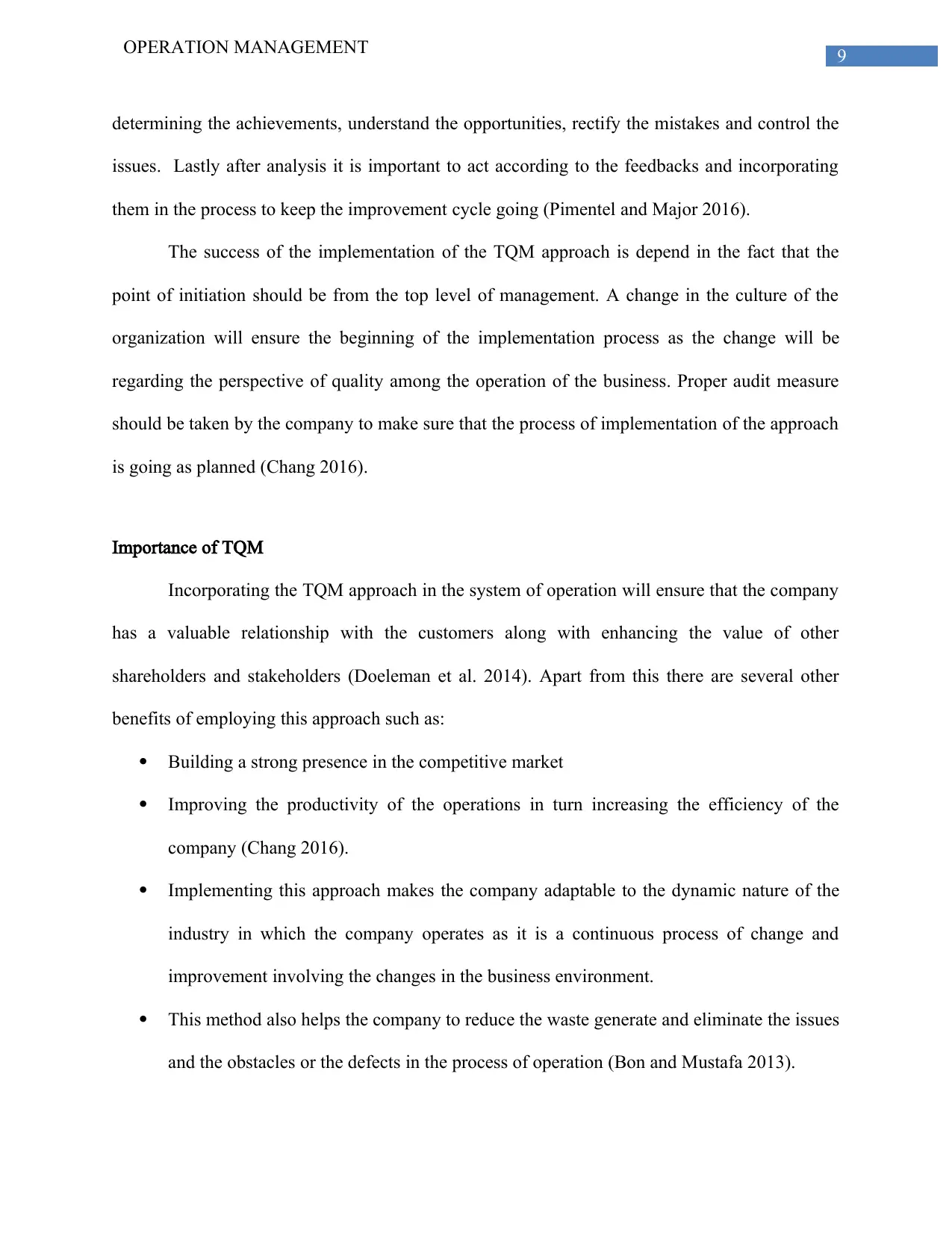
9OPERATION MANAGEMENT
determining the achievements, understand the opportunities, rectify the mistakes and control the
issues. Lastly after analysis it is important to act according to the feedbacks and incorporating
them in the process to keep the improvement cycle going (Pimentel and Major 2016).
The success of the implementation of the TQM approach is depend in the fact that the
point of initiation should be from the top level of management. A change in the culture of the
organization will ensure the beginning of the implementation process as the change will be
regarding the perspective of quality among the operation of the business. Proper audit measure
should be taken by the company to make sure that the process of implementation of the approach
is going as planned (Chang 2016).
Importance of TQM
Incorporating the TQM approach in the system of operation will ensure that the company
has a valuable relationship with the customers along with enhancing the value of other
shareholders and stakeholders (Doeleman et al. 2014). Apart from this there are several other
benefits of employing this approach such as:
Building a strong presence in the competitive market
Improving the productivity of the operations in turn increasing the efficiency of the
company (Chang 2016).
Implementing this approach makes the company adaptable to the dynamic nature of the
industry in which the company operates as it is a continuous process of change and
improvement involving the changes in the business environment.
This method also helps the company to reduce the waste generate and eliminate the issues
and the obstacles or the defects in the process of operation (Bon and Mustafa 2013).
determining the achievements, understand the opportunities, rectify the mistakes and control the
issues. Lastly after analysis it is important to act according to the feedbacks and incorporating
them in the process to keep the improvement cycle going (Pimentel and Major 2016).
The success of the implementation of the TQM approach is depend in the fact that the
point of initiation should be from the top level of management. A change in the culture of the
organization will ensure the beginning of the implementation process as the change will be
regarding the perspective of quality among the operation of the business. Proper audit measure
should be taken by the company to make sure that the process of implementation of the approach
is going as planned (Chang 2016).
Importance of TQM
Incorporating the TQM approach in the system of operation will ensure that the company
has a valuable relationship with the customers along with enhancing the value of other
shareholders and stakeholders (Doeleman et al. 2014). Apart from this there are several other
benefits of employing this approach such as:
Building a strong presence in the competitive market
Improving the productivity of the operations in turn increasing the efficiency of the
company (Chang 2016).
Implementing this approach makes the company adaptable to the dynamic nature of the
industry in which the company operates as it is a continuous process of change and
improvement involving the changes in the business environment.
This method also helps the company to reduce the waste generate and eliminate the issues
and the obstacles or the defects in the process of operation (Bon and Mustafa 2013).
Paraphrase This Document
Need a fresh take? Get an instant paraphrase of this document with our AI Paraphraser
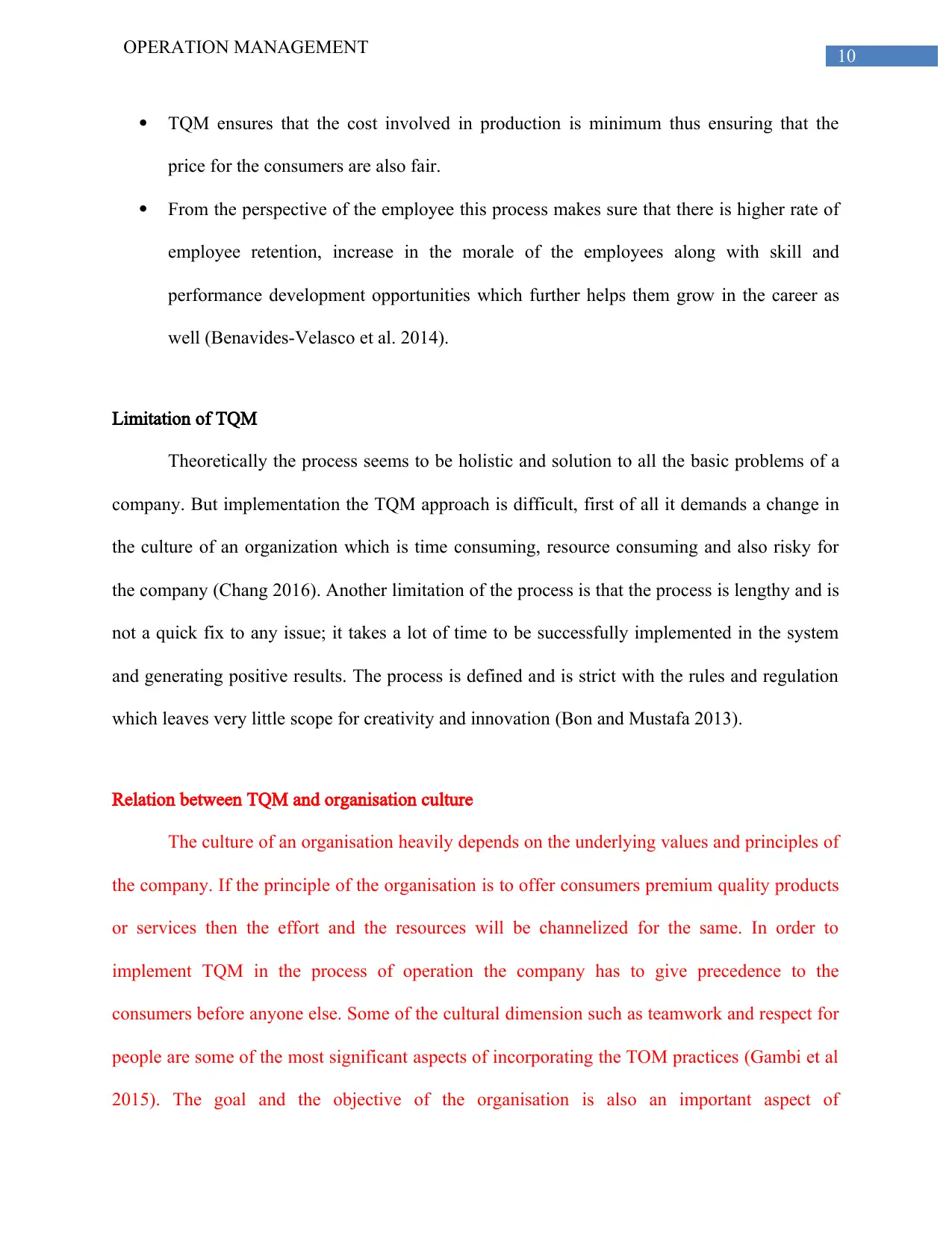
10OPERATION MANAGEMENT
TQM ensures that the cost involved in production is minimum thus ensuring that the
price for the consumers are also fair.
From the perspective of the employee this process makes sure that there is higher rate of
employee retention, increase in the morale of the employees along with skill and
performance development opportunities which further helps them grow in the career as
well (Benavides-Velasco et al. 2014).
Limitation of TQM
Theoretically the process seems to be holistic and solution to all the basic problems of a
company. But implementation the TQM approach is difficult, first of all it demands a change in
the culture of an organization which is time consuming, resource consuming and also risky for
the company (Chang 2016). Another limitation of the process is that the process is lengthy and is
not a quick fix to any issue; it takes a lot of time to be successfully implemented in the system
and generating positive results. The process is defined and is strict with the rules and regulation
which leaves very little scope for creativity and innovation (Bon and Mustafa 2013).
Relation between TQM and organisation culture
The culture of an organisation heavily depends on the underlying values and principles of
the company. If the principle of the organisation is to offer consumers premium quality products
or services then the effort and the resources will be channelized for the same. In order to
implement TQM in the process of operation the company has to give precedence to the
consumers before anyone else. Some of the cultural dimension such as teamwork and respect for
people are some of the most significant aspects of incorporating the TOM practices (Gambi et al
2015). The goal and the objective of the organisation is also an important aspect of
TQM ensures that the cost involved in production is minimum thus ensuring that the
price for the consumers are also fair.
From the perspective of the employee this process makes sure that there is higher rate of
employee retention, increase in the morale of the employees along with skill and
performance development opportunities which further helps them grow in the career as
well (Benavides-Velasco et al. 2014).
Limitation of TQM
Theoretically the process seems to be holistic and solution to all the basic problems of a
company. But implementation the TQM approach is difficult, first of all it demands a change in
the culture of an organization which is time consuming, resource consuming and also risky for
the company (Chang 2016). Another limitation of the process is that the process is lengthy and is
not a quick fix to any issue; it takes a lot of time to be successfully implemented in the system
and generating positive results. The process is defined and is strict with the rules and regulation
which leaves very little scope for creativity and innovation (Bon and Mustafa 2013).
Relation between TQM and organisation culture
The culture of an organisation heavily depends on the underlying values and principles of
the company. If the principle of the organisation is to offer consumers premium quality products
or services then the effort and the resources will be channelized for the same. In order to
implement TQM in the process of operation the company has to give precedence to the
consumers before anyone else. Some of the cultural dimension such as teamwork and respect for
people are some of the most significant aspects of incorporating the TOM practices (Gambi et al
2015). The goal and the objective of the organisation is also an important aspect of
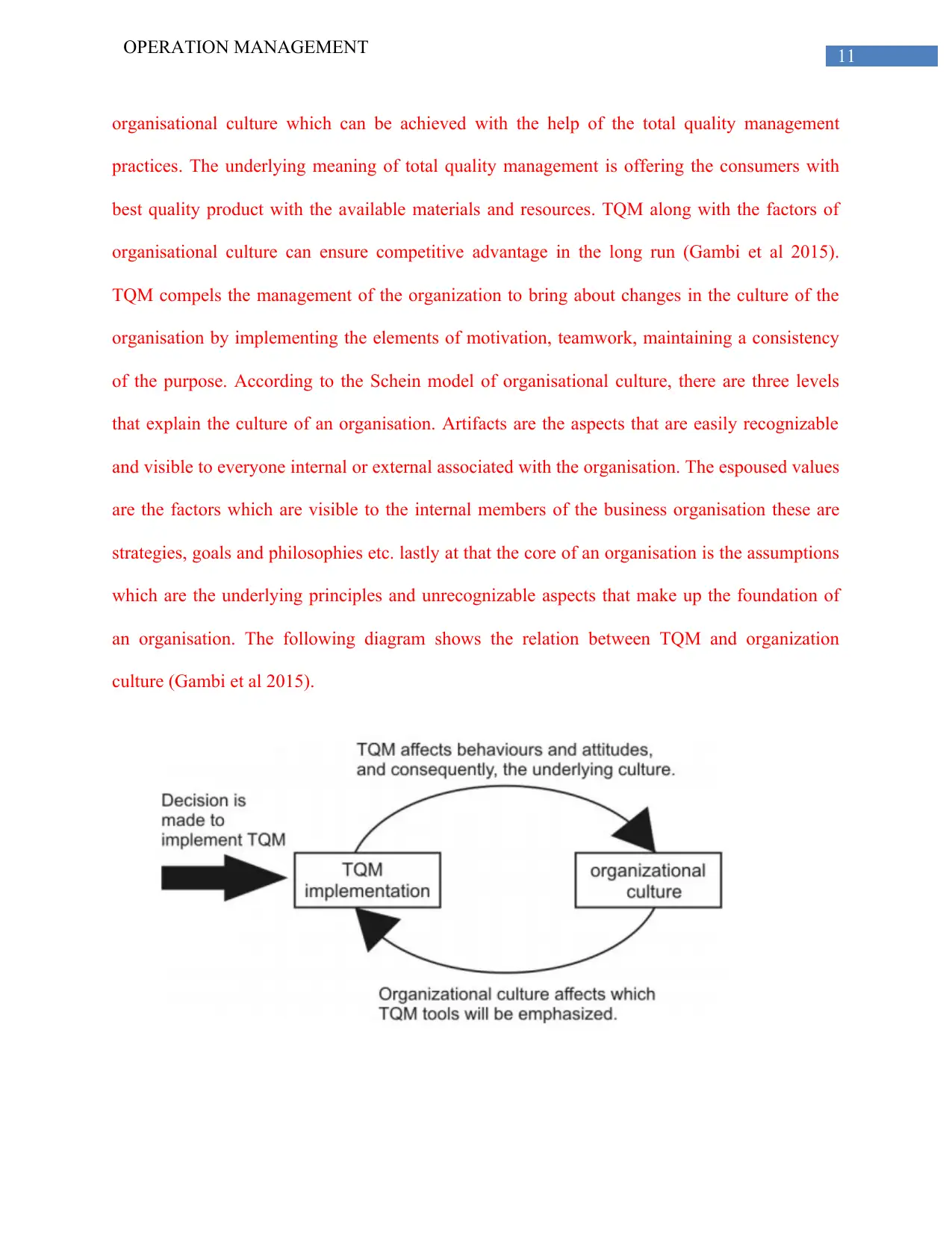
11OPERATION MANAGEMENT
organisational culture which can be achieved with the help of the total quality management
practices. The underlying meaning of total quality management is offering the consumers with
best quality product with the available materials and resources. TQM along with the factors of
organisational culture can ensure competitive advantage in the long run (Gambi et al 2015).
TQM compels the management of the organization to bring about changes in the culture of the
organisation by implementing the elements of motivation, teamwork, maintaining a consistency
of the purpose. According to the Schein model of organisational culture, there are three levels
that explain the culture of an organisation. Artifacts are the aspects that are easily recognizable
and visible to everyone internal or external associated with the organisation. The espoused values
are the factors which are visible to the internal members of the business organisation these are
strategies, goals and philosophies etc. lastly at that the core of an organisation is the assumptions
which are the underlying principles and unrecognizable aspects that make up the foundation of
an organisation. The following diagram shows the relation between TQM and organization
culture (Gambi et al 2015).
organisational culture which can be achieved with the help of the total quality management
practices. The underlying meaning of total quality management is offering the consumers with
best quality product with the available materials and resources. TQM along with the factors of
organisational culture can ensure competitive advantage in the long run (Gambi et al 2015).
TQM compels the management of the organization to bring about changes in the culture of the
organisation by implementing the elements of motivation, teamwork, maintaining a consistency
of the purpose. According to the Schein model of organisational culture, there are three levels
that explain the culture of an organisation. Artifacts are the aspects that are easily recognizable
and visible to everyone internal or external associated with the organisation. The espoused values
are the factors which are visible to the internal members of the business organisation these are
strategies, goals and philosophies etc. lastly at that the core of an organisation is the assumptions
which are the underlying principles and unrecognizable aspects that make up the foundation of
an organisation. The following diagram shows the relation between TQM and organization
culture (Gambi et al 2015).
⊘ This is a preview!⊘
Do you want full access?
Subscribe today to unlock all pages.

Trusted by 1+ million students worldwide
1 out of 15
Related Documents
Your All-in-One AI-Powered Toolkit for Academic Success.
+13062052269
info@desklib.com
Available 24*7 on WhatsApp / Email
![[object Object]](/_next/static/media/star-bottom.7253800d.svg)
Unlock your academic potential
Copyright © 2020–2025 A2Z Services. All Rights Reserved. Developed and managed by ZUCOL.





